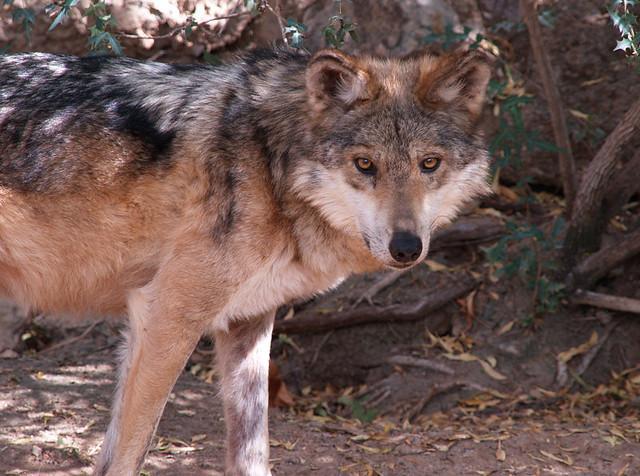Is the Mexican Wolf in Danger of Extinction?


The Mexican wolf (Canis lupus baileyi), also known as the lobo, is a subspecies of gray wolf that once roamed the southwestern United States and Mexico. However, due to habitat loss, predator control programs, and hybridization with domestic dogs, this iconic species was brought to the brink of extinction in the early 20th century.
In the upcoming AnimalWised article, we will delve into the question of whether the Mexican wolf is in danger of extinction. We'll explore the threats facing this species, the ongoing conservation efforts, and provide an update on its current status.
Characteristics and distribution of the Mexican wolf
The Mexican wolf, scientifically known as Canis lupus baileyi, is a subspecies of the gray wolf native to North America.
Mexican wolves are the smallest subspecies of gray wolves, with males typically weighing between 23 to 36 kilograms (50 to 80 pounds) and females ranging from 18 to 27 kilograms (40 to 60 pounds). They have a distinctive appearance, featuring a mix of gray, black, white, and reddish-brown fur. The fur on their backs often has a distinctive "cap" of black.
Mexican wolves are social animals that typically live in packs, which are organized groups led by an alpha pair. They are carnivorous predators, primarily preying on deer and elk, but their diet can also include smaller mammals.
The Mexican wolf bears significant cultural importance rooted in indigenous traditions and historical practices. Revered as a symbol of war and the Sun in Pre-Columbian Mexico, the wolf was crossbred with dogs in Teotihuacan to produce loyal guardians, exemplifying intentional human-wolf interactions. Engaging in religious rituals, wolves were ritually sacrificed, with their heads used as attire for priests and warriors, and remaining body parts symbolically placed in underground funerary chambers.
Is the Mexican wolf in danger of extinction?
Yes, the Mexican wolf is in danger of extinction. It is the most endangered subspecies of gray wolf in the world.
The Mexican wolf's decline can be traced back to the early 20th century when it became the target of extermination campaigns, driven by fears of predation on livestock. Trapping, poisoning, and habitat loss decimated the wolf's numbers, pushing it to the edge of oblivion.
The Mexican wolf has been listed as an endangered species since 1976, and conservation efforts have been implemented to recover its population.

Threats to the Mexican wolf
The Mexican wolf faces a multitude of threats that have contributed to its endangered status and make its survival a challenging endeavor. These threats can be categorized into various groups, each with its unique impact on the wolves' well-being and continued existence. Let us take a closer look at each one:
Persecution and poaching
As mentioned before, the Mexican wolf has long faced persecution, driven primarily by concerns about livestock predation and competition for game. This persecution has led to direct killings of wolves, both illegal and legal, and has created a climate of fear and animosity among some livestock owners and communities. Human-wolf conflicts continue to pose a significant threat to the species, even with conservation efforts in place.
Additionally, illegal hunting and poaching of Mexican wolves represent a direct and immediate threat to their survival. This illegal activity is driven by factors such as the value of wolf parts in the black market.
Habitat loss and fragmentation
The loss and fragmentation of the Mexican wolf's natural habitat stand as a significant hurdle to their survival. Habitat fragmentation occurs when the remaining habitat is broken up into smaller, isolated patches. This fragmentation prevents wolves from freely moving between these areas, disrupting their migration patterns and limiting their access to prey. The Mexican wolf thrives in large, unbroken tracts of land, and habitat loss and fragmentation directly impede their ability to maintain healthy populations.
Genetic issues and inbreeding
The Mexican wolf population experienced a severe bottleneck in the past, resulting in a significant reduction in genetic diversity. This genetic bottleneck has left the species vulnerable to inbreeding depression, a phenomenon that occurs when closely related individuals mate repeatedly. Inbreeding can lead to a range of health and reproductive issues, further weakening the already endangered population.
Furthermore, hybridization with coyotes, a closely related species, poses a significant threat to the genetic integrity of the Mexican wolf. Mating between wolves and coyotes can lead to the production of hybrid offspring, diluting the unique genetic characteristics of the Mexican wolf.
Disease risks
Mexican wolves are susceptible to diseases transmitted by domestic animals, such as canine distemper and parvovirus. These diseases can be particularly devastating to both wild and captive populations, causing widespread mortality and disrupting the recovery efforts.
Climate change
The effects of climate change pose an additional threat to the Mexican wolf, particularly in the form of altered ecosystems and changes in prey availability. Shifts in temperature and precipitation patterns can affect the distribution of suitable habitats and the abundance of prey species, making it more challenging for wolves to find sufficient food.
Limited prey base
The availability of natural prey, such as deer and elk, is essential for the Mexican wolf's survival. Habitat degradation and human activities that affect prey populations can have a detrimental impact on the wolves' ability to find sufficient food in the wild.
Curious about the key distinctions between coyotes and wolves? Delve further into the intricate world of these canines in our in-depth article.

Conservation strategies for the Mexican wolf
In 1976, the Mexican wolf was listed as endangered under the Endangered Species Act (ESA), and a comprehensive conservation effort was launched to save the species from extinction. This effort has involved a variety of strategies, including:
- Captive breeding: a captive breeding program has been established to increase the Mexican wolf population and provide wolves for reintroduction into the wild. The program currently houses over 300 Mexican wolves at 50 facilities in the United States and Mexico.
- Reintroduction: Mexican wolves have been reintroduced to the wild in Arizona and New Mexico, their ancestral home. Since 1998, over 140 wolves have been released into the wild.
- Habitat restoration: efforts are underway to restore and manage habitat for Mexican wolves, including reforestation, controlling wildfires, and reducing livestock grazing.
- Public education and outreach: public education and outreach programs are working to raise awareness about the Mexican wolf and its conservation challenges. These programs aim to reduce public fear and hostility towards wolves, and to promote sustainable coexistence between wolves and humans.
Despite the progress that has been made, the Mexican wolf still faces a number of challenges, including habitat loss, illegal killings, and hybridization with coyotes. The population remains small and fragmented, and the long-term survival of the species is still uncertain.
However, the conservation effort for the Mexican wolf is a success story, and it provides hope for other endangered species. By working together, we can save the Mexican wolf and ensure its continued existence in the wild.
Current status of the Mexican Wolf (2023)
As of February 2023, the Mexican wolf population in the United States has reached a new high of 241 individuals, up from 196 in 2021. This is a significant milestone in the conservation of this endangered subspecies.
Intrigued by the fascinating diversity among wolves? Discover the distinct characteristics of different wolf species in our comprehensive guide.

If you want to read similar articles to Is the Mexican Wolf in Danger of Extinction?, we recommend you visit our Endangered animals category.
- Boitani, L., Phillips, M. & Jhala, Y. (2018). Canis lupus. The IUCN Red List of Threatened Species.
- Gannon, M. (2014). First Litter of Wild Wolf Pups Born in Mexico . Available at: https://www.livescience.com/46898-mexico-first-wild-born-wolves.html.
- Harding, L.E., Heffelfinger, J., Paetkau, D., Rubin, E., Dolphin, J., & Aoude, A. (2016). Genetic management and setting recovery goals for Mexican wolves (Canis lupus baileyi) in the wild . Biological conservation.
- Sosa Rodríguez, AP (2017). Recovery and analysis of historical records of coexistence of human communities with the Mexican wolf (Canis lupus baileyi) from the South-Southeast of Mexico (Doctoral dissertation . Institute in Biological Sciences-Bachelor in Biology-UNICACH).








